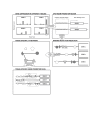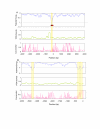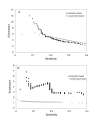Identification of tissue-specific cis-regulatory modules based on interactions between transcription factors
- PMID: 17996093
- PMCID: PMC2194798
- DOI: 10.1186/1471-2105-8-437
Identification of tissue-specific cis-regulatory modules based on interactions between transcription factors
Abstract
Background: Evolutionary conservation has been used successfully to help identify cis-acting DNA regions that are important in regulating tissue-specific gene expression. Motivated by increasing evidence that some DNA regulatory regions are not evolutionary conserved, we have developed an approach for cis-regulatory region identification that does not rely upon evolutionary sequence conservation.
Results: The conservation-independent approach is based on an empirical potential energy between interacting transcription factors (TFs). In this analysis, the potential energy is defined as a function of the number of TF interactions in a genomic region and the strength of the interactions. By identifying sets of interacting TFs, the analysis locates regions enriched with the binding sites of these interacting TFs. We applied this approach to 30 human tissues and identified 6232 putative cis-regulatory modules (CRMs) regulating 2130 tissue-specific genes. Interestingly, some genes appear to be regulated by different CRMs in different tissues. Known regulatory regions are highly enriched in our predicted CRMs. In addition, DNase I hypersensitive sites, which tend to be associated with active regulatory regions, significantly overlap with the predicted CRMs, but not with more conserved regions. We also find that conserved and non-conserved CRMs regulate distinct gene groups. Conserved CRMs control more essential genes and genes involved in fundamental cellular activities such as transcription. In contrast, non-conserved CRMs, in general, regulate more non-essential genes, such as genes related to neural activity.
Conclusion: These results demonstrate that identifying relevant sets of binding motifs can help in the mapping of DNA regulatory regions, and suggest that non-conserved CRMs play an important role in gene regulation.
Figures





Similar articles
-
De novo prediction of cis-regulatory elements and modules through integrative analysis of a large number of ChIP datasets.BMC Genomics. 2014 Dec 2;15:1047. doi: 10.1186/1471-2164-15-1047. BMC Genomics. 2014. PMID: 25442502 Free PMC article.
-
Predicting tissue specific cis-regulatory modules in the human genome using pairs of co-occurring motifs.BMC Bioinformatics. 2012 Feb 7;13:25. doi: 10.1186/1471-2105-13-25. BMC Bioinformatics. 2012. PMID: 22313678 Free PMC article.
-
Identifying cis-regulatory modules by combining comparative and compositional analysis of DNA.Bioinformatics. 2006 Dec 1;22(23):2858-64. doi: 10.1093/bioinformatics/btl499. Epub 2006 Oct 10. Bioinformatics. 2006. PMID: 17032682
-
Organizing combinatorial transcription factor recruitment at cis-regulatory modules.Transcription. 2018;9(4):233-239. doi: 10.1080/21541264.2017.1394424. Epub 2017 Nov 28. Transcription. 2018. PMID: 29105538 Free PMC article. Review.
-
Parsing regulatory DNA: general tasks, techniques, and the PhyloGibbs approach.J Biosci. 2007 Aug;32(5):863-70. doi: 10.1007/s12038-007-0086-0. J Biosci. 2007. PMID: 17914228 Review.
Cited by
-
Predicted trans-acting siRNAs in the human brain.Int J Mol Sci. 2015 Feb 3;16(2):3377-90. doi: 10.3390/ijms16023377. Int J Mol Sci. 2015. PMID: 25654231 Free PMC article.
-
Motifs and cis-regulatory modules mediating the expression of genes co-expressed in presynaptic neurons.Genome Biol. 2009;10(7):R72. doi: 10.1186/gb-2009-10-7-r72. Epub 2009 Jul 1. Genome Biol. 2009. PMID: 19570198 Free PMC article.
-
Two different classes of co-occurring motif pairs found by a novel visualization method in human promoter regions.BMC Genomics. 2008 Mar 1;9:112. doi: 10.1186/1471-2164-9-112. BMC Genomics. 2008. PMID: 18312685 Free PMC article.
-
Modelling transcriptional regulation with a mixture of factor analyzers and variational Bayesian expectation maximization.EURASIP J Bioinform Syst Biol. 2009;2009(1):601068. doi: 10.1155/2009/601068. Epub 2009 Jun 11. EURASIP J Bioinform Syst Biol. 2009. PMID: 19572011 Free PMC article.
-
Eukaryotic genomes may exhibit up to 10 generic classes of gene promoters.BMC Genomics. 2012 Sep 28;13:512. doi: 10.1186/1471-2164-13-512. BMC Genomics. 2012. PMID: 23020586 Free PMC article.
References
-
- Berman BP, Nibu Y, Pfeiffer BD, Tomancak P, Celniker SE, Levine M, Rubin GM, Eisen MB. Exploiting transcription factor binding site clustering to identify cis-regulatory modules involved in pattern formation in the Drosophila genome. Proc Natl Acad Sci U S A. 2002;99:757–762. doi: 10.1073/pnas.231608898. - DOI - PMC - PubMed
-
- Berman BP, Pfeiffer BD, Laverty TR, Salzberg SL, Rubin GM, Eisen MB, Celniker SE. Computational identification of developmental enhancers: conservation and function of transcription factor binding-site clusters in Drosophila melanogaster and Drosophila pseudoobscura. Genome Biol. 2004;5:R61. doi: 10.1186/gb-2004-5-9-r61. - DOI - PMC - PubMed
Publication types
MeSH terms
Substances
Grants and funding
LinkOut - more resources
Full Text Sources
Miscellaneous

